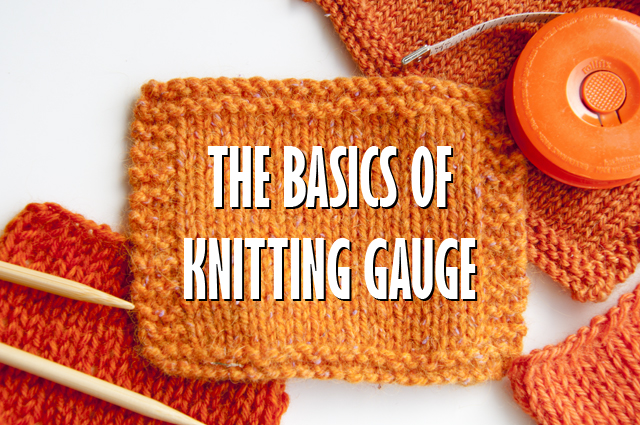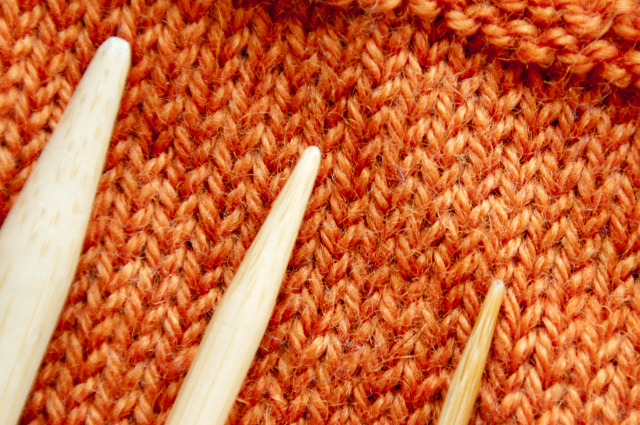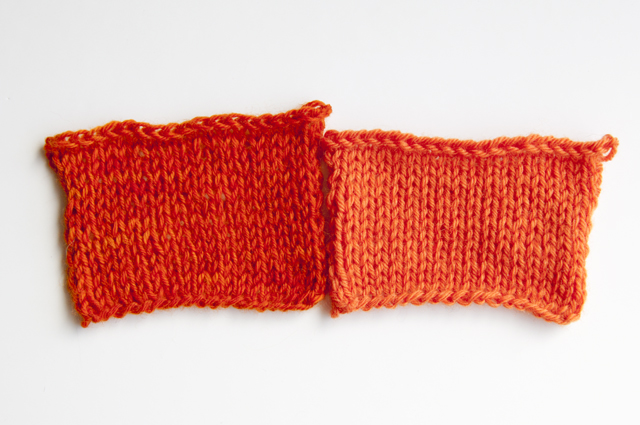
Oh, gauge! So important but also so annoying. You knit a 5 inch x 5 inch swatch, wash and block it, carefully measure the stitches and rows, and it doesn’t match what you want. Trying to match the recommended gauge on a pattern can cause a lot of frustration, but once you understand what’s going on, you have more options to try to change your gauge. There a three major factors that influence gauge: knitter’s technique, knitting needles, and the yarn itself.
The first, the knitter’s technique, is the hardest to changes. Some people knit tightly or loosely, and it doesn’t matter if they’re knitting Continental or English, but for some knitters, changing up their technique can make a significant difference. Although most knitters wouldn’t want to knit a whole sweater using a different knitting style than their old favorite, experimenting with different techniques is definitely something worth trying as a last ditch effort, especially if your purling gauge differs from your knitting gauge. On top of that, some knitters will grip knitting needles made from different materials differently which can make a slight difference in gauge. My own knitting technique changes when I use metal needles instead of bamboo needles, so I can manipulate my gauge by switching my needles. Knitting technique is the reason why you can use the exact same yarn and the exact same needles as the designer of a pattern but never match their gauge.

Next would be the knitting needle diameters. Going up or down a needle size will make a difference in your gauge. Large needles will give you fewer stitches per inch, and smaller needles will give you more stitches per inch. This is the easiest way to adjust your gauge, and it’s the reason why most knitters have a large collection of knitting needles. It can seem daunting and frustrating to buy all of those needles when you’re a new knitter, but they’re one time purchases for the most part, and you really do need them.
Last but not least is the yarn itself. All yarn is not created equal. Two yarns that are both called worsted weight can give you different gauges. There are tons of factors involved, from fiber content to spinning technique, that all will affect the gauge the yarn knits up at. Note that all of this also affects the yardage usage which is why you should always take yardage estimates with a grain of salt. If you’d like to learn more about yarn construction so you can make better yarn substitution choices, I highly recommend Clara Parke’s The Knitter’s Book of Yarn.

Here we have two different worsted weight superwash wool yarns knit on 5 mm needles by the same person. Each swatch is 20 sts by 14 rows, but there’s a clear row gauge difference, and the fabrics are different, too. The swatch on the left has fewer rows per inch than the swatch on the right, and you can see glimpses of the table through the gaps between the stitches. It’s also a looser knit fabric and drapes slightly differently. The swatch on the left is floppy when I pick it up, and the stockinette can barely show its curl. The swatch on the right is a slightly denser, more structured fabric and curls easily.
Gauge issues can be a sign that you chose the wrong yarn substitution. The all-too-often ignored row gauge is a great indicator that your substitution isn’t quite right. You can go up or down needle sizes until you get your target stitch gauge from a clearly wrong yarn choice. I can knit worsted weight on 5 mm needles to get 4.5 sts per inch, and I can knit bulky yarn on 3.75 mm to get 4.5 sts per inch, and I can also knit fingering weight yarn on 6.5 mm needles to get 4.5 sts per inch. All three of these give me different row gauges, and only one is the right fabric. The different row gauges are a red flag that although the stitch gauge matches, the fabric isn’t right.
Sometimes a yarn choice just isn’t right for a project and you’re never going to get the right fabric; that’s when it’s time to either find a different pattern or pick out different yarn. But if you’re creating a fabric that looks close to the sample in the pattern and is only off by one or two stitches or rows over four inches, and you’ve done what you can with your needle size and knitting technique, it’s time to adapt your pattern. We’ll get to that later this week.
Leave a Reply